First Drive: 2007 Nissan Sentra SE-R Spec V

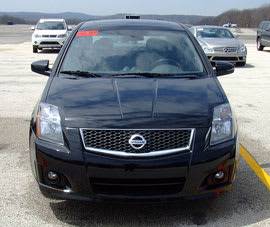
The lesser 2007 Sentra trim levels have been on sale since last year, but there’s been no SE-R Spec V since the previous generation retired. Now it’s here, and what better place to test a high-performance model than on a track? However, the SE-R left our writers a bit perplexed about its go-fast aspirations.
Joe Wiesenfelder: I was looking forward to this redo, in part because the 2006 didn’t cut the mustard … or even the custard, which, I think you’ll agree, is marginally easier to cut. Also, the redesigned Sentra improves on the previous gen, and I hoped Nissan would dial it up on this version, too. Having driven the new one, I’m sad to say I’m disappointed.
The only thing the old Spec V had going for it was an engine larger than the high-revving type of, say, a Honda Civic Si. The 2.5-liter four-cylinder gave it more low-rev torque for launching off the line and powering out of turns. The new generation again gives you a 2.5-liter four-cylinder in place of the regular Sentra’s 2.0-liter. Even though the power is higher at 200 hp, up from 175 hp in the old Spec V, the torque peak has stayed at 180 pounds-feet, and it comes at higher engine speeds — 5,200 rpm rather than 4,000 rpm. This car is also nearly 400 pounds heavier. Numbers don’t always tell the story, but this time they do: The car feels sluggish when accelerating, only pouring on at higher engine speeds.
The old Spec V was never much of a handler, and though this one isn’t sloppy, it also failed to impress. On the racetrack, I was sure the tires had to be all-seasons; they just didn’t have the grip. In fact they are summer performance tires. They give up traction gradually and aren’t dangerous, but neither do they glue the car to the pavement as we’ve come to expect.
In a sense, the car’s better aspects are gone, and its shortcomings aren’t dramatically improved. Some competitors that use smaller engines now get superior torque from them by means of well-executed turbochargers. (You know turbos … the ones you expect to be weak off the line.) Where competitors have added it, the Sentra has taken low-rev torque away. Granted, cars like the Mazdaspeed3 and VW GTI are more expensive, but it’s not only about cost. When you have a Sentra, Sentra S, Sentra SL and the ostensibly sporty Sentra SE-R and Sentra SE-R Spec V, shouldn’t the top-of-the-line deliver more and compete better? Nissan isn’t a clueless company, but we’re a long way from the scrappy 1991 model that introduced the SE-R badge. This version is a missed opportunity.”
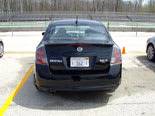
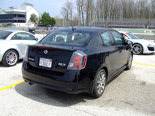
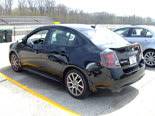
David Thomas: I too was really excited that the SE-R was at the event. I’ll admit, I read great things about it in other publications, but after taking it on the track I couldn’t believe anyone could pen glowing words about its performance prowess. In fast turns, the SE-R felt like it was ready to tip over, and that limited how hard I wanted to press it. The tires didn’t help either, as the grip was hardly reassuring, as Joe mentioned.
I had to hop into the new Mitsubishi Lancer GTS right afterward because I had just reviewed it and remembered how great it handled corners in the real world. Not to my surprise, it handled the track better than the SE-R even though it might not have been as fast through the gears. And remember, the Lancer GTS isn’t going to be that model’s top performance trim. There will be a larger engine coming to it in the future, and of course the next Evo. I won’t even list all the other cheap speed demons that bested the SE-R on the track, but they included the Mini Cooper S and Mazdaspeed3.
Oh, I almost forgot — to get this performance, Nissan put crossbars behind the backseat to improve rigidity and handling. That means no fold-down rear seats. D’oh! So, the performance isn’t that much better and you lose utility. Great. I did dig the red stitching and seat belts, and the upgraded stereo. None of that would get me to line up for another ride on the track, though.”

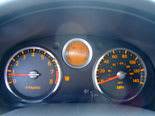
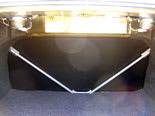
Mike Hanley: In the Sentra SE-R Spec V’s defense, I’ve only driven a handful of production cars that have felt at home on Road America’s fast four-mile circuit. I didn’t take the car on the track, but instead opted for some country roads surrounding it and came away with a more favorable opinion of the car than Joe and Dave.
The Spec V responds well to driver commands, and tossing it around on the winding roads near Elkhart Lake, Wis., proved to be entertaining. Its ride and handling reminded me of Subaru’s Impreza WRX, and the short-throw six-speed manual transmission is positioned high, which puts it in easy reach of your right hand. Even though the 2.5-liter four-cylinder is pretty noisy and the steering has a little too much assist to be considered sporty, the compact sedan’s fun factor seems reasonable for the money.

Former managing editor David Thomas has a thing for wagons and owns a 2010 Subaru Outback and a 2005 Volkswagen Passat wagon.
Featured stories




